Spannagelhöhle
Useful Information

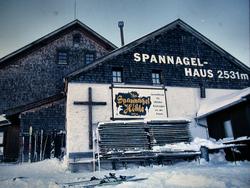
| Location: |
Spannagelhaus.
A12 Exit 39 Wiesing/Achensee/Zillertal, 169 south, turn right in Mayerhofen into Tuxer Tal. From Hintertux at the end of the road take the Hintertuxer Gletscherbahn to the Ferner Gletscherhaus. The Spannagelhaus is 10 min downhill. (47.079875, 11.671564) |
| Open: |
JUN to mid-JUL daily 12-14. Mid-JUL to mid-SEP daily 10-15. Mid-SEP to mid-OCT daily 12-14. Mid-OCT to APR Sun-Fri 13-14. Tours every hour on the full hour. [2025] |
| Fee: |
Cable Car:
Adults EUR 36, Children (10-15) EUR 23. Glacier Cave: Adults EUR 22.50, Children (6-14) EUR 14. [2025] |
| Classification: |
 Karst Cave Karst Cave
 river cave
marble (Jurassic Hochstegenkalkmarmor) river cave
marble (Jurassic Hochstegenkalkmarmor)
|
| Light: |
 Electric Light Electric Light
|
| Dimension: | A=2,521 m asl, L=12,500 m, D=25 m. |
| Guided tours: | L=500 m, D=60 min, MinAge=6, MinSize=1.20 m. |
| Photography: | allowed |
| Accessibility: | no |
| Bibliography: |
Max H. Fink (1961):
Die Höhle unter dem Spannagelhaus
Österreichische Touristenzeitung (Wien) 74 (6): 70

Gerhard Schirmer (1976): Die Höhle beim Spannagelhaus Österreichische Touristenzeitung (Wien) 88 (9): 109–111 
Ernest Jacoby, Günter Krejci (1992): Die Höhle beim Spannagelhaus und ihre Umgebung, Tuxer Alpen (Tirol) Wissenschaftliche Beihefte zur Zeitschrift "Die Höhle", 26, Verband österreichischer Höhlenforscher, Wien 1992  online
pdf
online
pdf
|
| Address: |
Spannagelhöhle, Familie Anfang, A-6293 Tux 223, Tel: +43-5287-87251.
E-mail: |
| As far as we know this information was accurate when it was published (see years in brackets), but may have changed since then. Please check rates and details directly with the companies in question if you need more recent info. |
|
History
| 22-AUG-1885 | lodge opened and named after Franz Xaver Wery. |
| 16-AUG-1908 | reopened after renovation and renamed Spannagelhaus. |
| 1919 | cave discovered by Alois Hotter, the landlord of the lodge at that time. |
| 1960 | cave exploration starts with Rudolf Radislovich who explored the entrance section. |
| 1961 | surveyed by Max H. Fink. |
| 1964 | declared a Naturdenkmal (Natural Monument) by the Bundesdenkmalamt. |
| 1968 | discoveries by Walter Knezicek und Günther J. Wolf. |
| 1970 | new passages discovered by Hannes Jodl. |
| 1972-1975 | survey by the Landesverein für Höhlenkunde in Tirol. |
| 1975 | hydrological exploration and dye tracing by the Groupe Spéléologique Luxembourgeois. |
| 1976/77 | 50-hour expedition led by E. Jacoby. |
| 1984 | survey of new discoveries. |
| 1987-1988 | garbage from the lodge removed. |
| 02-JUL-1994 | opened to the public. |
| 1995 | visitors part expanded. |
| 2013 | Spannagelhaus sold to the Zillertaler Gletscherbahn. |
Description


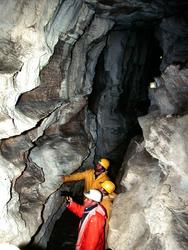
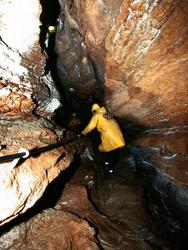
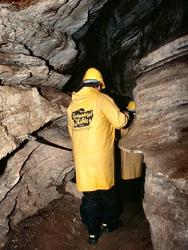
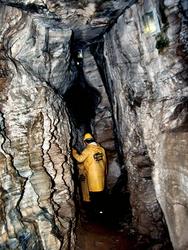
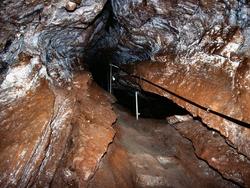
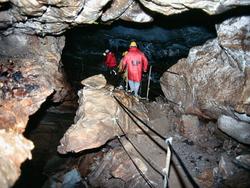
The Spannagel Cave is the second-highest show cave of Austria. It was developed by Josef Klausner, the landlord of the Spannagelhaus. Until 2008 it was the highest show cave of Austria, but in this year another show cave was opened on the same mountain, the Natur Eis Palast glacier cave which is locate at the next higher cakle car station. The cave was named after the Spannagelhaus lodge, which in return was named after Dr. Rudolf Spannagel, the president of the Österreichischen Touristenklubs (ÖTK, Austrian Tourist Club) from 1902 to 1904.
A trip to the Spannagel cave is either strenuous or expensive: this cave is located at the glacier of Hintertux high up the mountain, 2,521 m asl. So you have two possibilities: either you walk up to the cave or you take the cable car. This cable car is mainly for the skiers, who have an ideal situation here. In winter there are several ski routes down into the valley, in summer skiing is still possible on the glacier. At the lower rim of the glacier is the Spannagelhaus, a typical Austrian alpine lodge. To get there, you have to take the lower two of three subsequent cable car sections. The Spannagelhaus is 150 m below the station Tuxer Fernerhaus.
There is no ticket office for the cave, you just buy your tickets from the waitress in the lodge.
The tours start every hour, and you can efficiently use the waiting time for a snack.
Then the visitors are taken to a small room with some equipment.
All visitors get helmets, lamps and a special raincoat with the logo of the cave on the back.
Warm clothes, even in summer, good walking shoes, and gloves are a good idea.
However, you actually need those to reach the Spannagelhaus from the cable car, which is a walk across the glacier.
Skiers who want to visit the cave also get rubber boots, as it is not a good idea to visit the cave in skiing boots.
We think it’s better to use sturdy walking shoes, the cave is actually not very dirty, but probably a little slippery.
It seems the number of visitors is too low to offer tours during winter, although this is the main skiing season.
Now the tour starts, and after a few steps the entrance to the cave is reached, which is just 20 m below the hut.
The lodge sits on the edge, and a trail leads down to the entrance along the cliff face.
An iron bar gate locks the cave, and once inside the cave, you will see the typical character of the cave from the very first moment.
A rather narrow, wild and wrinkled passage through dark grey, striped marble with beautiful patterns.
The tour goes down the main passage, which is comparably spacious, the path is a little rough, more like a trail in the mountains, not as expected from a show cave.
After crossing two or three small rooms, which are just wider sections of the passage, a rope bridge across the dry ravine is reached.
The whole cave feels like walking through a Klamm, which is the local name for a slot canyon, a narrow and deep ravine.
The tour is now reaching its deepest point and offers a glimpse down a drop, which makes it impossible for the tourists to follow the main passage further on.
Cavers have climbed down and explored kilometers of cave system, which go across the hill, always restricted to the rather thin and folded band of soluble marble..
There are two more exits, one in the middle of a cliff face and one right at the lower station of the cable car.
The tour now returns to the entrance now through another passage which goes sideways, twisted and mazelike, to reunite with the main passage close to the cave entrance.
The first part is called Dünndarm (small intestine), and as I am a bit heavy, the guide wonders if I will fit through.
To be honest, with my belly and my photo bag it is definitely a bit tricky, but I enjoy the squeeze which reminds me about my caving past.
It’s a really narrow but high passage, meandering like a snake, but it is only a few meters long.
Now the tour follows some low side passages, climbing up iron ladders and ducking under low ceilings, until a passage which runs more or less parallel to the main passage is reached, which is only a bit smaller.
Following this passage upwards, it ends at the surface, but the exit is blocked by debris.
Through another side passage the main passage is reached, close to the entrance, and the cave is left.
Cave visit in 2002, Jochen Duckeck
This description of a visit may have convinced you that this cave tour is quite rough. But that’s actually not the case, the cave is developed and has electric light. There are some narrow and low passages, and even some iron ladders, so it is definitely not suitable for people which are physically handicapped. Visitors should be able to walk some distance and climb a bit, but that obviously applies to most caves. Caving or climbing experience is certainly not needed for this cave. And the interesting experience of the visit outweighs the physical exertions.
This cave is exceptional in many ways and fascinating. This cave is not in the typical alpine karst, which are located in two broad bands of limestone or dolostone mountains along the northern and southern rim of the Alps. The center of the Alps is formed of basement, crystalline rocks like granite, gneiss, slate, and so on. These are not soluble rocks, and there are no karst caves in the central Alps. This cave is the big exception, is located right in the middle of this crystalline area, in a thin layer of marble. The crystalline rocks are formed by plutonic processes deep inside the earth, and heat and pressure transformed a thin layer of limestone into dark marble. Then it was folded and uplifted, until it was 2,500 meters high. Now the glacier started its eroding work, and the overlaying rocks were removed. The folded band was truncated and so it runs through the flank of the mountain in an irregular shape. In warmer times, like today, the glacier end at the rim above this band. Melting water runs down on the surface of the impermeable rocks, until it reaches the marble. Here it enters the cracks and fills them until it finds an exit, much deeper where the marble layer again reaches the surface. This is called contact karst. So the marble was used by the water for thousands of years, and it reappeared in resurgences far below. On its way it formed the cave mostly by erosion, but also partly by solution of the marble.
Several remains of the cave forming processes were found inside the cave, which helps us to understand, how it developed.
There are rubbles of crystalline rock in the cave, which were transported, rounded and brought into the cave by fast flowing water.
We can imagine how forceful the water was flowing, to transport those head sized boulders.
And if there were vortexes in the stream, the water turned around in circles and the rock were also transported in circles, cutting almost circular holes into the floor like a big drilling machine, which are called
 potholes.
The rocks still lie in the holes, the water was not strong enough to actually lift them out of those tubs.
Quite characteristic is the small hill in the center, as the rocks were moved around on the outside.
And again the bands of the marble form beautiful patterns.
The cave has a great number of
potholes.
The rocks still lie in the holes, the water was not strong enough to actually lift them out of those tubs.
Quite characteristic is the small hill in the center, as the rocks were moved around on the outside.
And again the bands of the marble form beautiful patterns.
The cave has a great number of
 potholes.
They are typical for any
potholes.
They are typical for any
 river cave, but here they are quite huge and numerous.
This cave is a river cave, despite the lack of a river nowadays.
The reason why there is no river any more is easy: the glacier became much smaller in this warm interglacial, so it melts at another point and the melting water today uses a different path to flow down into the valley.
river cave, but here they are quite huge and numerous.
This cave is a river cave, despite the lack of a river nowadays.
The reason why there is no river any more is easy: the glacier became much smaller in this warm interglacial, so it melts at another point and the melting water today uses a different path to flow down into the valley.
The cave was discovered by Alois Hotter In 1919. He was the landlord of the Spannagelhaus, but as he was not a cave he called the cave a "horrible hole" and as a waste pit. Several tenants after him did the same. In 1960 cave exploration started with Rudolf Radislovich who explored the entrance section, about what is today used for the show cave. And actually the cave was continually explored since then until today, with new discoveries and surveys any few years. In the late 1980s the view on the cave had changed, even for the landlord of the lodge, who started to develop it as a show cave. The cavers had started to remove the rubbish, today it is completely gone. Also, the drainage of the toilets into the cave was replaced.
The Spannagelhaus belonged to the Österreichischer Touristenklub (Austrian Tourist Club), a non-profit organisation, for almost 130 years. However, the club did not run the lodge itself, but leased it out, which is why the landlord changed several times. The first reports about the cave appeared in the Österreichische Touristenzeitung (Austrian Tourist Newspaper), the official publication of the association. However, the Spannagelhaus was sold to the cable car company in 2013, partly because no new tenant could be found. The hut was demolished and replaced by a modern restaurant exclusively for skiers. It is only open in winter as it is not accessible on skis in summer. The cave entrance was apparently moved to a separate building at some point and is now operated independently.
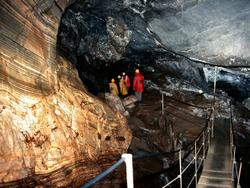
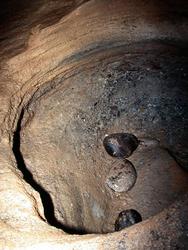
 Pothole. Spannagelhöhle, Austria.
Pothole. Spannagelhöhle, Austria.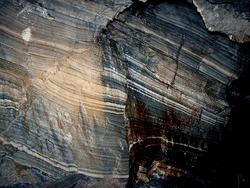

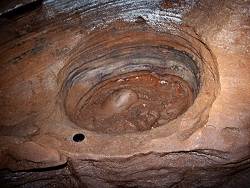
 pothole with the typical shape: circular with vertical rims. The rock in the pothole was turned around by the water forming the tub and becoming round itself. Spannagelhöhle, Austria.
pothole with the typical shape: circular with vertical rims. The rock in the pothole was turned around by the water forming the tub and becoming round itself. Spannagelhöhle, Austria.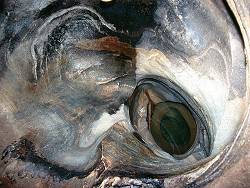
 pothole shows the structure of the marble very well. Spannagelhöhle, Austria.
pothole shows the structure of the marble very well. Spannagelhöhle, Austria.- See also
 Caves With a View
Caves With a View Search DuckDuckGo for "Spannagelhöhle"
Search DuckDuckGo for "Spannagelhöhle" Google Earth Placemark
Google Earth Placemark OpenStreetMap
OpenStreetMap Spannagel Cave - Wikipedia (visited: 18-MAY-2022)
Spannagel Cave - Wikipedia (visited: 18-MAY-2022) NATURDENKMAL SPANNAGELHÖHLE, official website
NATURDENKMAL SPANNAGELHÖHLE, official website  (visited: 21-JUL-2025)
(visited: 21-JUL-2025) Spannagel Cave natural monument (visited: 17-MAY-2022)
Spannagel Cave natural monument (visited: 17-MAY-2022) Die Höhlen bei Hintertux, A, by Franz Lindenmayr
Die Höhlen bei Hintertux, A, by Franz Lindenmayr  (visited: 17-MAY-2022)
(visited: 17-MAY-2022)
 Index
Index Hierarchical
Hierarchical Countries
Countries Maps
Maps